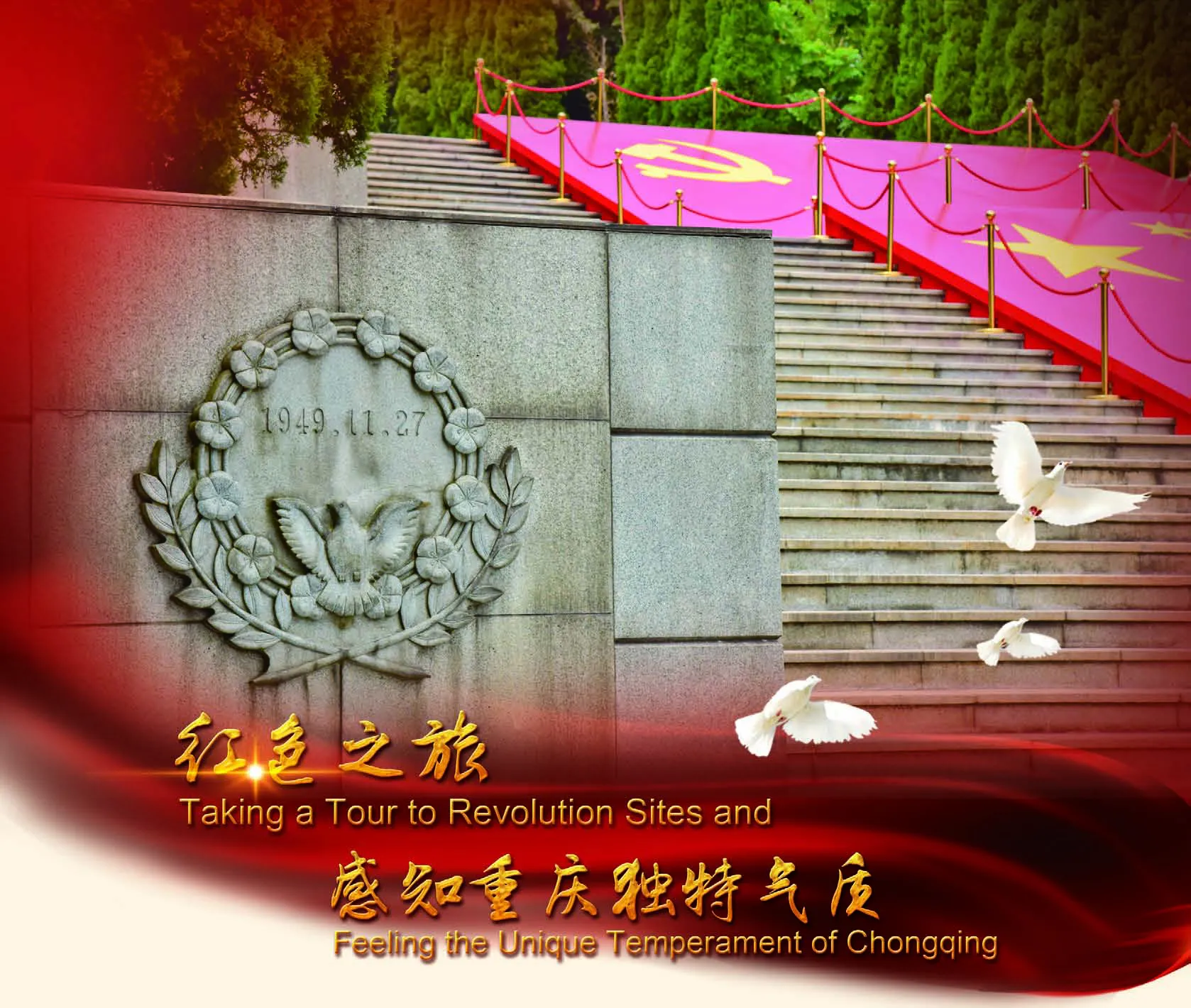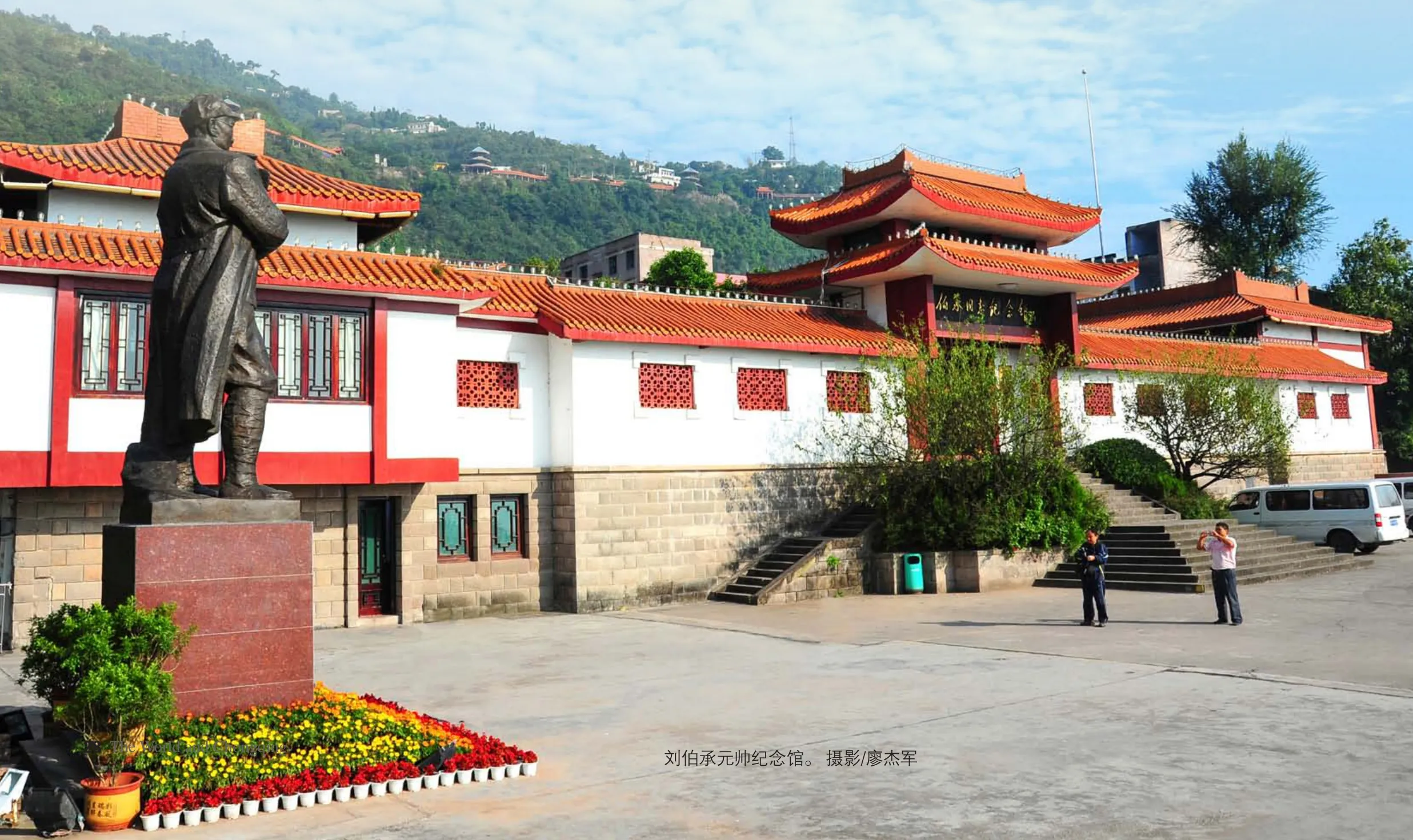红色之旅 感知重庆独特气质
2018-10-23贺煜唐安冰
□ 文/本刊记者 贺煜 图/本刊记者 唐安冰

重庆歌乐山烈士陵园。
人们钟爱重庆,不仅因为这里的山水“颜值”高,还因为这里地域文化“气质”好,深厚的红色基因滋养着这座城市的灵魂。
重庆,有红军的足迹,有革命将领的故里,军民鱼水情深。
重庆,有众多抗战遗址,红岩精神代代相传。
在这火红的十月,来重庆开启一场“红色之旅”吧!探访红色遗址,走进革命老区。
探访红色遗址
重庆主城区红色旅游资源丰富,景点主要分布在渝中区、沙坪坝区、南岸区等地。
渝中区是重庆母城,有许多革命遗存、传承红色火种的地方。这里有全国唯一一座纪念中华民族抗日战争胜利的国家纪念碑—人民解放纪念碑;有李子坝抗战遗址公园、重庆大轰炸惨案遗址、宋庆龄旧居陈列馆等;还有红岩革命纪念馆革命遗址群,包括重庆红岩革命纪念馆、红岩村13号(八路军驻渝办事处旧址)、周公馆、桂园、中共代表团驻地旧址、《新华日报》营业部旧址等多处革命遗址。
红岩革命纪念馆是抗日战争时期中共中央南方局和八路军驻重庆办事处所在地。周恩来、董必武、叶剑英等老一辈革命家曾长期生活、战斗于此,在这里建立的丰功伟绩和所培育的红岩精神,使这片红色土地名扬中外,成为著名的革命圣地和全国爱国主义教育基地;桂园是原国民党上将张治中的公馆,1945年10月10日,毛泽东与周恩来代表共产党同国民党代表在此谈判并签订了《国共双方代表会谈纪要》(即“双十协定”),桂园成为国共谈判的重要见证地;周公馆是周恩来工作的地方;《新华日报》被毛泽东誉为“新华军”的先锋和尖兵。这些都是抗日战争时期中共中央南方局的活动基地,是共产党在国民党统治区巩固和发展抗日民族统一战线、领导人民群众进行革命斗争的中心。现已成为重庆具有代表性的红色旅游地。

中山四路桂园。

① 周公馆前周恩来塑像。

② 白公馆内游人如织。
沙坪坝区的红色旅游景点代表当数渣滓洞、白公馆、歌乐山烈士陵园等,是来重庆必游的旅游景点。郁郁葱葱的歌乐山,曾被列为古巴渝十二景之一。但在20世纪40年代,因“渣滓洞”“白公馆”两座集中营而变成阴森恐怖之地……如今这里游客聚集,乘往来旅游巴士沿线游览。
南岸区南山风景区,有重庆抗战遗址博物馆,是重庆抗战文化中具有代表性、保存最完整和相对集中的一处文物大遗址。内有云岫楼(蒋介石官邸)、草亭(美国总统特使马歇尔旧居)、松厅(宋美龄别墅)等13处文物。该遗址作为抗日战争时期军事、政治、外交的一个重要场所,是抗日战争和世界反法西斯战争一些重大历史事件的重要见证,客观记载着抗战期间,重庆作为中国战时首都的那段历史。
寻访红色遗址,重庆是海内外游客的不二选择。

③ 位于南山的重庆抗战遗址博物馆。

④ 抗战时期,重庆是军事、政治、外交的重要场所。
走进革命老区
在区县,重庆有“10+4”红色故里。即潼南、开州、江津、黔江、巴南、永川、合川、长寿、綦江、大足等10个红军将领的故乡,和彭水、酉阳、秀山、城口等4个红军长征经过的区县。如今,“10+4”红色故里已结成“重庆市红色旅游联盟”,全面打造重庆红色旅游“升级版”。
江津聂荣臻元帅陈列馆、潼南杨尚昆故里、酉阳赵世炎故居、开州刘伯承元帅纪念馆及故居……走进这些红军将领的故居、纪念馆,瞻仰革命圣地,缅怀革命先辈,了解红色革命历史。
沿着红军的步履,走进彭水、酉阳、秀山、城口等区县,见证那个战争年代的浴血奋战、鱼水情深。
彭水留有许多关于红军的传奇事迹。现存主要红军历史遗迹有黄家镇的红三军驻地旧址、县城的南渡沱红军渡口遗址和红军渡广场等10余处,正逐步形成红色旅游带。
酉阳南腰界群山秀丽,清幽寂静,是贺龙、任弼时、关向应等老一辈无产阶级革命家领导创建的川黔湘鄂革命根据地,也是重庆市唯一的省级苏维埃政权,留有红军生活和战斗的足迹。景区完好地保存着红三军司令部旧址、红军会师纪念亭、南腰界区苏维埃成立大会会址、大坝场战斗遗址等革命遗址景点共5 6处。


川陕革命根据地城口苏维埃政权纪念碑。
在美丽的边城秀山,则有见证军民鱼水情的红军洞、红军桥,更有镌刻黔东独立师奋战历史的川河盖战斗遗址。此外,还有红三军司令部遗址、倒马坎战斗纪念碑等多处红军战斗遗址,红色旅游资源非常丰富。
城口是川陕革命根据地的重要组成部分,是重庆第一个打出红军旗帜的县、第一个由地方红军攻占县城的县、第一个迎来中国工农红军主力部队的县,唯一成建制建立了县、区、乡、村各级苏维埃政权的革命老区,素有“红色城口”的美称。锈蚀的大刀、火药筒,防滑鞋钉、刻着口号的手雷……在川陕苏区城口革命根据地历史陈列馆的这些老物件,浓缩了历史的斑驳记忆,讲述着川东游击队、红三十三军的铁血历程。站在苏维埃政权纪念碑前,敬佩之情油然而生……
忆往昔,岁月铮铮,光辉熠熠。看今朝,赴“红色之旅”,铭记历史,开启新征程!
图片/开州区委宣传部 城口县委宣传部提供
That people love Chongqing is not only because of the good-looking of the landscape, but also for the “pretty temperament” of the regional culture and the deep red gene nourishing the soul of the city.
There are the footsteps of the Red Army and the hometown of revolutionary generals in Chongqing, also the military and civilians are close as fish and water here.
Chongqing, there are many revolution sites, the spirit of Hongyan has been passed down from generation to generation.
Come on and embark on the tour of revolution sites in this fiery October to seek the revolutionary ruins and walk into the old revolutionary areas.
Seek the Revolution Ruins
Chongqing’s main districts are rich in red tourism resources,and the scenic spots are mainly distributed in Yuzhong District,Shapingba District and Nan’an District.
As the mother city of Chongqing, Yuzhong District possesses many places where revolutionary remains and red flames are passed down. In addition to the only national monument in the country to commemorate the victory of the Chinese nation in the War of Resistance against Japan - the Monument to People’s Liberation, there are the Liziba Historic Park of the War of Resistance Anti-Japan, the Chongqing Bombing Massacre Site, and the Former Residence Exhibition Hall of Soong Ching-ling, etc. Also, the revolutionary historic sites of the Hongyan Revolution Memorial Hall, including the Chongqing Hongyan Revolution Memorial Hall, Hongyan Village No. 13 (the former office of the Eighth Route Army in Chongqing),Zhougongguan, Guiyuan, the former Residence of the Chinese Communist Party delegation, and the former site of the Xinhua Daily, can be found here.
Chongqing Hongyan Revolution Memorial Hall was the seat of the Southern Bureau of the CPC Central Committee and the Chongqing Office of the Eighth Route Army during the War of Resistance against Japan. Zhou Enlai, Dong Biwu, Ye Jianying and other older revolutionists had lived and fought for a long time. Their great achievements and the cultivated Hongyan spirit here have made this red land famous both at home and abroad, becoming a famous revolutionary holy land and national patriotism education base; Guiyuan was the mansion of the former the Kuomintang (KMT) general Zhang Zhizhong. On October 10, 1945, Mao Zedong and Zhou Enlai on behalf of the Communist Party negotiated with representatives of the Kuomintang and signed the “Summary of Talks between the Representatives of the KMT and Those of the CPC” (the October 10th Agreement), thus,Guiyuan has became an important witness for the negotiation between the Kuomintang and the Communist Party; Zhou Residence was the place where Zhou Enlai worked; Xinhua Daily was praised by Mao Zedong as the pioneer and the leader of the “Xinhua Army”. These are the activity bases of the Southern Bureau of the CPC Central Committee during the War of Resistance against Japan and the center for the Communist Party to consolidate and develop the anti-Japanese national united front and lead the people to carry on the revolutionary struggle in the national government areas. Now, they have become the most representative red tourism destinations in Chongqing.
Zhazidong Prison, Baigongguan Prison,Geleshan Martyrs Cemetery, etc. are the representatives among the red tourist attractions in Shapingba District and are the must-see tourist attractions in Chongqing. The lush Gele Mountain has been listed as one of the twelve scenic spots in old Chongqing. However, it became a horrific and scary place due to the two concentration camps of Zhazidong Prison, Baigongguan Prison in the 1940s... Nowadays, tourists gather here and take a tour along the sites by the tourist buses.
Chongqing Anti-Japanese War Remains Museum is in the Nanshan Scenic Area of Nan’an District and it is a representative, the most preserved and relatively concentrated cultural relic site in Chongqing’s Anti-Japanese War culture.There are 13 cultural relics including Yunxiaolou(the official residence of Chiang Kai-shek), Grass Pavilion (the former residence of American President’s special envoy Marshall), and Pine Hall(Soong May-ling’s Villa). As an important place for military, political, and diplomatic affairs during the War of Resistance against Japan, the site is an important testimony to some major historical events in the War of Resistance against Japan and the World Anti-Fascist War. It has objectively recorded the history of Chongqing as the wartime capital of China during the Anti-Japanese War.
It is the best choice for tourists from both home and abroad to visit the revolutionary sites in Chongqing.
Walking into the Old Revolutionary Base Area
In the districts and counties of Chongqing, there exist “10+4”revolutionary hometowns. They are the hometowns of 10 Red Army generals such as Tongnan, Kaizhou, Jiangjin, Qianjiang, Banan,Yongchuan, Hechuan, Changshou, Qijiang, and Dazu, and the counties where the Red Army’s Long March passed through, including Pengshui,Youyang, Xiushan and Chengkou. At present, the “10+4” revolutionary hometowns have entered the “Chongqing Red Tourism Alliance” to fully create the “upgraded version” of Chongqing red tourism.
Nie Rongzhen Marshal Exhibition Hall in Jiangjin District, Yang Shangkun’s former residence in Tongnan District, Zhao Shiyan’s former residence in Youyang, Kaizhou Liu Bocheng Marshal Memorial Hall and former residence in Kaizhou... Walking into the former residences and memorial halls of these generals of Red Army, we can commemorate the revolutionary predecessors and know about the history of the Red Revolution through our visits to these sacred places of the revolution.
Walk along the steps of the Red Army and enter Pengshui,Youyang, Xiushan, Chengkou and other districts and counties, you will witness the bloody battles and that the military and civilians were close as fish and water in the war years.
There are many legends about the Red Army in Pengshui. The existing main historical sites of the Red Army include the Red Army’s former residence site in Huangjia Town, the Red Army Ferry Crossing Site in Nandutuo and the Red Army Ferry Crossing Square in the county,which have formed a red tourist belt.
The mountains and hills of Nanyaojie are delicate and pretty, beautiful and quiet in Fuyang, which is the Sichuan-Guizhou-Hunan-Hubei Revolutionary Base created by the leaders of the older generation of proletarian revolutionists such as He Long, Ren Bishi and Guan Xiangying.It is also the only provincial-level Soviet Regime in Chongqing, with the life and battle footprints of the Red Army. Fifty-six revolution sites such as the site of the Red Army Command, the memorial hall of the Red Army Joining Forces, the site of the Founding Assembly of Soviet Union in Nanyaojie, and the battle site of Dabachang are well preserved in the scenic spot.
In the beautiful border town of Xiushan, there are Red Army Caves and Red Army Bridges that have witnessed the military and civilians being close as fish and water, and there is also a battle site of the Chuanhegai that engraves the history of the Eastern Guizhou Independent Division.In addition, there are many red army battle sites such as the Red Army Command and the Daomacan Battle Monument, etc. The red tourism resources are very rich here.
Chengkou is an important part of the Sichuan-Shanxi Revolutionary Base. It is the first county in Chongqing to raise the Red Army flag, the first county to be captured by the local Red Army, and the first county to greet the main force of the Chinese Workers’ and Peasants’ Red Army and the only one old revolution base area that established the Soviet Regime at the county, district, township and village level, which is famous as the “Red Chengkou”.Corroded knives, gunpowders, non-slip studs, grenades with slogans... these old objects in Chengkou historical museum of Sichuan-Shanxi Revolutionary Bases have enriched the history of mottled memories and told the bloody courses of the guerrillas of Eastern Sichuan and the 33th Army of the Red Army. Standing in front of the Soviet Regime monument,one’s admiration arises spontaneously...
When recalling the past, the years were bright and shining to the later generations. Looking at the present, the red tour of revolution will cause people to remember history and embark on a new journey!
Photos/ the Publicity Department of Kaizhou District Committee, the Publicity Department of Chengkou County Committee
